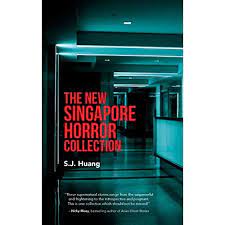
© Marshall Cavendish
Here’s a review of another book that’d make an appropriate Halloween present tomorrow…
A while ago on this blog, I wrote, “When you’re in a new culture, a good way to get insight into that culture is to read a selection of traditional ghost and horror stories from the place. Finding out what makes people scared and finding out how they like to scare others give you some appreciation of their psychology.”
Thus, after I arrived in Singapore earlier this year, and found myself for the first time in a Singaporean bookstore (Kinokuniya in the Takashimaya Shopping Centre on Orchard Road), and saw a volume called The New Singapore Horror Collection by local author S.J. Huang, I immediately purchased it. Not that the 13 short stories inside are what you’d call ‘traditional’. They don’t have historical settings or folkloric ghosts or monsters. Huang’s stories take place in the 21st century and in a modern-day Singapore that’s instantly recognisable to me. It’s the place I see every day from the windows of my apartment, my office and the bus I take to work. Also, while the horrors featured in many of these stories may be supernatural, they may equally be psychological, created by the minds of their beleaguered protagonists as events tip them over the edge.
Huang’s work still provides insight into the character and culture of the formidable city-state they’re set in. Boasting the second-highest GDP per capita in the world, Singapore is one of the biggest economic success stories of the past 50 years. But in a society where so much value is placed upon ambition, drive and work-ethic, there are inevitably a few casualties – people who can’t handle the pressure. And some of Huang’s most effective stories explore what happens when those casualties end up in dark places indeed.
The main character of The Office, for example, quickly unravels when he finds himself trapped and alone in his workplace one evening, 66 floors up. This is just after he’s heard that the former colleague he pushed aside in order to get a promotion has committed suicide by jumping off another tall building. In Penance, a man who’s always in a hurry – presumably for work-related reasons – causes a fatal traffic accident one day. He escapes prosecution, but then becomes the subject of a bizarre and madness-inducing haunting that has his mind working at ever-increasing speeds his body can’t keep up with: “His eyes and the corners of his mouth twitched as if they had a life of their own, quickened by a manic pulse of electricity that coursed through his features every few seconds. It was exhausting to watch, and I could only imagine what it had to be like for him.” In The Last Goodbye, a loser who messes up a lucrative business deal desperately summons supernatural forces and makes a bargain with them to turn the situation around. Or does he? Perhaps he merely imagines that he has. Then, after the business deal somehow turns good again and he’s rewarded with a promotion, he realises he has to honour his side of the supernatural bargain he (might have) made…
Elsewhere, there are many references to contemporary Singaporean life: national service, which provides the male characters with something to reminisce about, years later, as they start to slip into middle age; the country’s HDB (Housing and Development Board) public housing, which accommodates the majority of the population, but which high-flyers look down on (someone sneers in The Last Goodbye, “As the VP of Sales and Distribution, he was probably the most senior guy at the bank still living in public housing. It’s totally ridiculous”); the nightlife, which forms the starting point for Taken for a Ride, another psychological horror tale, one that has a nice, nasty twist; and the conservative social attitudes, which form the context for the sad ghost story Lines.
Singapore’s education system also gets a look-in with Lights, in which two teams of competitive schoolboys play a ‘wargame’ on one of their school’s sports fields, at night-time, with the floodlights turned off – carrying red or blue light-sticks to show their position and their team’s identity. There’s an uneasy undercurrent to the game because, some time before, one of their fellow pupils disappeared without trace while crossing the same field after dark. And when the spectators notice mysterious lights of a different colour starting to appear on the black field, while the game is in progress, things become truly creepy… In fact, I’d say Lights is my favourite story in the collection. There’s no explanation given for what ultimately happens, which makes it creepier.
Although there’s a Poe-esque emphasis on the psychological, Huang also finds room to experiment and a few stories go off on unexpected tangents. The Elixir is essentially an old-fashioned Egyptian-mummy tale, although the embalmed cadaver featured isn’t ancient Egyptian, but ancient Chinese, the concubine of a cruel, long-ago emperor. The Chinese authorities, it transpires, have entrusted her perfectly-preserved body to a ‘Singapore government research agency’ to determine the composition of her mysterious embalming fluid. Charmingly, The Elixir reminded me of the 1971 Hammer horror movie Blood from the Mummy’s Tomb which, similarly, didn’t feature a lumbering, bandaged mummy but a miraculously-undecayed lady from ancient times.
Meanwhile, The Legacy takes place in 2031. It has astronauts from “the Perses program… founded on 2nd February 2025, as a joint initiative between the Republic of Singapore and the United States of America,” landing on Mars and discovering a cave that leads into a strange extraterrestrial cathedral or temple. Inevitably, things then take a dark turn. The Legacy is initially reminiscent of the movie Alien (1980) – or God help us, Lifeforce (1985) – but its final paragraphs made me think of the social satire / comet-disaster film Don’t Look Up (2021).
I felt The Elixir and The Legacy were the least effective stories in the collection, as they seemed a little too ‘far out’ to be properly disturbing, though I did find both of them good fun.
Overall, I really enjoyed The New Singapore Horror Collection. I especially appreciated S.J. Huang’s prose, which is straightforward, solid and unshowy – and all the better for that. I look forward to his next collection, which I trust will further explore, to good effect, the sinister side of Singapore.



